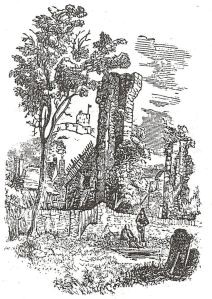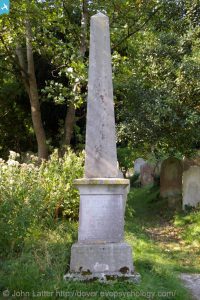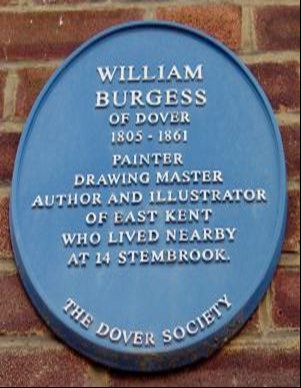It recognises, arguably, Dover’s greatest artist. William Burgess was born, in 1805, and educated in Canterbury then served an apprenticeship in the city at his uncle’s coach building business He then he set off to travel around Europe with a fellow artist Thomas Sydney Cooper. They were not very successful in selling their paintings so William returned to England. He then moved to Dover in 1828, married Harriet, from Deal, and settled down in a small cottage in Woolcomber Street, before moving to a corner property at 14 Stembrook with customers door in Castle Street. Here they just managed to survive by selling William’s commissions for drawings and landscapes of Dover and giving the occasional pupil art lessons. He was now starting to be recognised as an artist with some of his work exhibited at the Royal Academy and by the Royal Society of British Artists.

St Martin-le-Grand by William Burgess © Dover Museum
One of his earliest works, dated 1929, is a pencil sketch of St Martin le Grand and is held in the town museum in the Market Square.
Slowly things improved and in 1844 William opened the Cosmorama, at 14 Stembrook, an exhibition ahead of its time. He placed his artwork behind large frames with convex glass to resemble looking through a window.
This was very popular to the wealthy visitors Dover attracted in those days, particularly his prints of Shakespeare Cliff. As business improved he expanded the scope of Cosmorama, demand increased gaining more commissions for his work and there was a greater call for his services as an art teacher. William and Harriot then moved to a larger premises at 26 High Street on the boundary between Dover and the village of Charlton.
A tragic accident occurred on 9th August 1860 at Archcliffe Fort, Dover. Three sixty year old 32 pounder guns were being fired at a target in the channel. No. 2 gun had already been fired ten times that evening, when, Mr Hadlow, the gunner responsible for firing, applied the slow match. It was a massive shock when the gun exploded. Lieutenant George Thompson, a solicitor and coroner for the borough died almost instantly and was interred in the family vault at St Andrews Church in Shepherdswell. Sergeant John Monger, of Snargate Street, Dover, was taken to the South Front Military Hospital, South Military Road, about a quarter of a mile away but died on arrival. He was buried with full military honours at Cowgate Cemetery. Later a memorial obelisk was erected at the head of his grave.

John Monger Obilisk Cowgate
Cowgate Cemetery is looked after by volunteers from the Dover Society.
The print of William’s painting of the military cortege of Sergeant Monger from South Front Military Hospital turned out to be his best seller.
Less than a year later William died, age 55, on 30th July 1861. Harriet remarried and died on 7th August 1884
A fuller article on William Burgess by Lorraine Sencicle can be found on the Dover Historian Website;
https://doverhistorian.com/2013/07/05/william-burgess-artist/
Alan Lee


